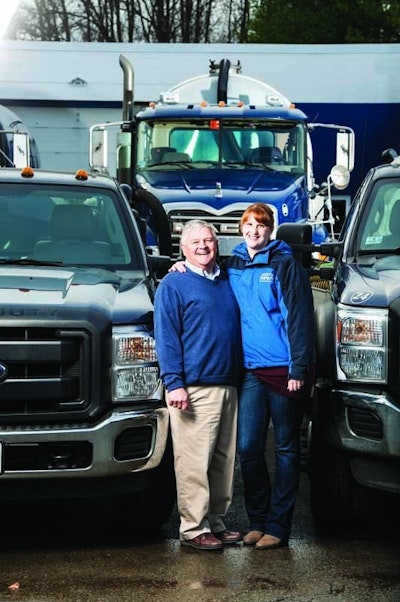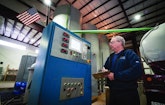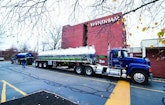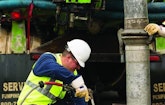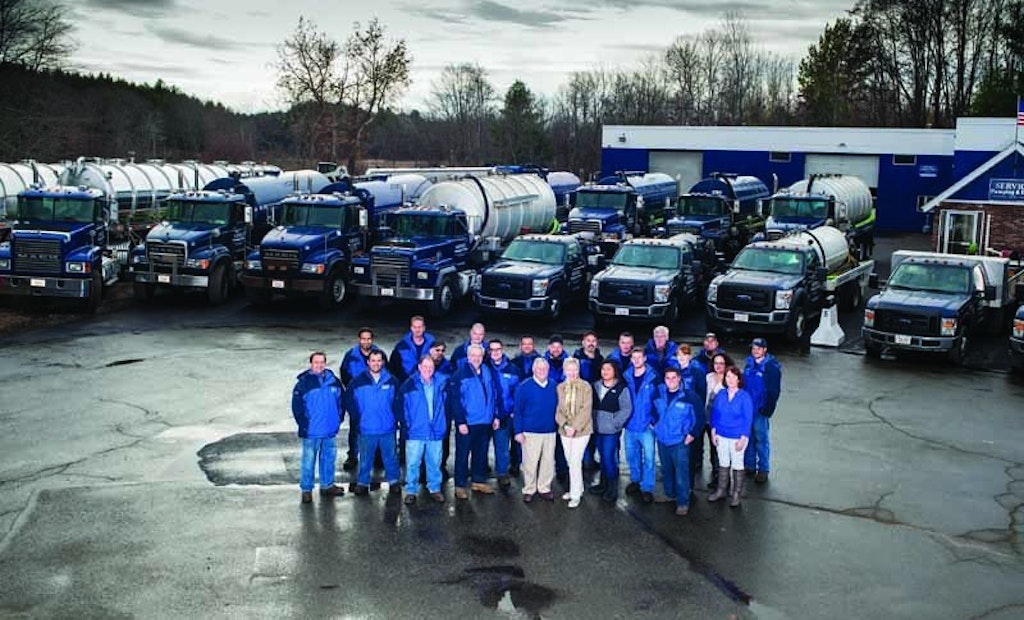
Interested in Trucks?
Get Trucks articles, news and videos right in your inbox! Sign up now.
Trucks + Get AlertsDick Mottolo has been in the septic business since 1972, and in the ‘80s was a featured contractor in an early issue of the fledgling Pumper magazine. Since then his business has grown, service offerings have changed and the industry has evolved. Some of his biggest changes came from the next generation, particularly his nudge into the technology requirements of the 21st century. But there was an unexpected twist to the story.
His son, Anthony, grew up working alongside him, but as Dick began to focus more on commercial work, Anthony decided to go out on his own and concentrate on residential septic pumping. Meanwhile, his daughter, Lara, who had never been particularly interested in the business, left a theater career in New York, came home and stepped into the family business. She worked her way up through the ranks, modernizing the company as she went.
Service Pumping & Drain Co. Inc. is located in North Reading, Massachusetts. The 14 technicians and eight office personnel, including Dick’s wife, Carolyn, operate out of a 5-acre property and a 10,000-square-foot building, housing offices and a 15-bay garage. They work within a 100-mile radius covering Boston, eastern Massachusetts and southern New Hampshire.
A CHANGE IN FOCUS
Dick got started in the business when he purchased the company from the Hewitt family who had founded it in 1927. His background was raising pigs. “I knew nothing about this business except it was a necessity that probably would survive any downturns,” he says. He laughs when he recalls he only put $500 down. “Nowadays we can spend twice that on just one flotation tire on one of these trucks.”
He started off with two employees and two trucks and has grown every year since. And he’s done it without a sales force. “We just try to give top service consistently, no excuses, and we have a great team of people.”
In the beginning, the work was about 90 percent residential and 10 percent commercial. But gradually Dick began focusing more on commercial, and today those figures are reversed. “It just evolved,” he says. “As your overhead gets higher, you have to have the commercial because you couldn’t afford to pay the benefit packages I do with just residential.”
However, he’s not about to abandon residential customers, some of whom have been with the company for over 50 years. “I have a great deal of satisfaction with long-term customers,” he says. Lara adds it rounds out the hours. “A lot of commercial you can only do in the morning or at night, so it’s nice to have the residential during the day,” she says.
THE FRONT END
The move to commercial has also given the company a more diversified customer base, which Dick says offers protection from economic downturns and keeps the crew busy year-round. Besides pumping septic tanks, they clean catch basins, sediment pits and storm drains. They also work on car washes, parking garage drains and commercial swimming pool filters.
“And we do a lot of maintenance on lift stations and often work with various mechanics, plumbers, engineers, general contractors, municipalities and other pumpers,” Dick says. They are also licensed to do septic system inspections.
The regulatory landscape for storm drains has changed drastically over the years, Dick says, increasing their work in that area. “You’ve got new regulations all the time,” he says, “especially with new construction where they have to have a storm management plan in place. We make up a custom form for each location and number all the structures, and every quarter go in and check each one to make sure there’s no issues, and then clean them once a year. We’ve always done it, but now we’re more focused on it than ever. ”
A fair amount of their work is emergencies, but they always try to turn that into recurring maintenance work orders. “We want to keep the customer out of having a backup and keep them in compliance with regulations,” Dick says. Lara adds it’s also a good way to grow your business: “If companies can create a recurring work order or reminder for every emergency, they have a better chance of increasing the lifetime value of the customer – but you have to be proactive about it.”
Collecting grease was always a small part of Dick’s business, but it now accounts for half their work. “We do hundreds of restaurants, but also colleges, hospitals, food manufacturers, hotels, malls,” Dick says – anything from 10 gallons to 20,000. The industry has changed considerably. “Back in the ‘70s, they just assigned you a manhole and there was no documentation,” he says.
When regulations came in requiring disposal at treatment plants, Dick says it became difficult to find places that would take grease, a problem he finally solved when he came across an opportunity in 2002 to buy a small grease-processing facility. He made major improvements and now runs it as a separate business, Northeast Environmental Processing. The facility removes water from food wastewater and sends the residual material to farm digesters, making electricity. That’s another change he’s seen in the industry – “Now food waste recycling is very vogue,” he says.
MACHINES AND TRUCKS
Equipment includes a 2010 Bobcat S205 skid-steer loader, US Jetting 4018 portable jetters, Spartan Tool cameras, and RIDGID cameras and locators.
The fleet includes eight 1985 to 2006 Mack vacuum trucks with 4,000- and 5,000-gallon tanks (half are aluminum, half steel) and National Vacuum Equipment 866 pumps, most from Andert, TSI Tank Services and Longhorn Tank & Trailer.
For smaller jobs and low-entry situations, they have two Ford F‑350 vacuum trucks (2015 and 2016) with 525-gallon steel Presvac tanks, one with a Jurop/Chandler pump, the other Masport; one Ford F‑550 with a 1,200-gallon aluminum tank and Masport pump built out by Arthur Custom Tank; and two Ford F-350s with trailered US Jetting jetters (300 and 600 gallons).
For larger projects, they have three 9,000-gallon aluminum vacuum tank trailers built by Arthur Custom Tank and a 1969 Fruehauf 8,500-gallon aluminum transport pulled by Mack tractors (a 1993 R713 and a 2006 CHN613), a 2008 Aquatech B-10 (10-yard) and a 2000 Vactor 2112 (12-yard).
To maintain the fleet, Dick works with two independent mechanics who come in at night and on weekends. “Safety is paramount,” he says. “We do whatever it takes to keep them in good shape.” He also likes to have spare equipment. “I usually have one or two extra trucks ready to go in case a truck is down. That way my drivers always have a day’s work and we don’t have to make excuses to our customers.”
THE BACK END
A solid back office is required to ensure the front end operates as efficiently and effectively as possible, Dick says, and it has to keep up with changes and growth. Lara has worked hard to improve operations in this area.
After working 10 years on the administrative side of theater management after getting a degree from Fordham University, Lara was ready to make a change and in 2006 joined her father, a move that surprised both of them. She began familiarizing herself with every back office function, eventually working her way up to general manager, then vice president handling operations, marketing, financial and back-end functions.
One major contribution was taking a deep dive into technology — a real game changer for the company, Dick says. “When I first started I had a beeper, and then I went to a pay phone and put my quarters in and called the answering service. Now everything’s on the cloud.”
About eight years ago the company installed Fleetmatics REVEAL vehicle-tracking software and in 2015 added Fleetmatics WORK, a cloud-based customer relations software and computerized dispatching program that integrates with QuickBooks accounting software. Drivers access schedules and route information with an app on their Samsung Galaxy Note smartphones. Dick says the value of software like this can’t be overestimated.
“Your key to profitability is efficient dispatching, efficient routing because traffic is a major issue, and efficient handling of the customers so they feel like they know you, you know them and you know what their needs are,” he says.
Lara also implemented an Internet-based phone system and refreshed the website created by Anthony and his wife, Mary. She says technology in a large company is a necessity, but cautions that it doesn’t run on autopilot. “You really do need to have someone in the office who has some computer knowledge and is willing to take the time to learn and work with these programs.”
THE PEOPLE
As critical as technology is to a business, Dick and Lara never lose sight of the fact that employees are their best asset. “Without good people, you can’t provide the high level of service,” Dick says. “And you can’t afford turnover either. It takes a couple years to train a guy. And customers like to see familiar faces.”
Besides good pay and benefits, Lara says Dick treats people fairly and respectfully. “They’re our eyes and ears — they’re the ones representing the company. They all know they’re valued.” A number of employees have been with the company 10 and 20 years.
Dick credits Lara with upgrading company handbooks, formalizing the hiring process, and professionalizing the human resources function. “Years ago, management was by the seat of the pants,” he says. “But as you get a little larger, you really do have to manage.”
THE FUTURE
The mom-and-pop business Dick bought more than 40 years ago looks nothing like the sophisticated commercial operation he has today. Even Lara has seen big changes in just the last 10 years — customers are more savvy, they expect faster turnaround and 24‑hour accessibility, and there’s increased regulations, recordkeeping and reporting requirements.
At 73, Dick says he still has his commercial driver’s license and could jump in a truck if he had to, but he mostly looks out for the big picture. He has no plans to retire but is comfortable he’s got a great team, led by Lara and 27-year veteran General Manager John Nicholas.
Lara’s grateful to be there. “I wasn’t expecting to like it as much as I do, but it’s a very challenging industry, it’s fast-paced and it’s constantly changing.” She’s also proud she and Dick have developed a great working relationship. “Family businesses can be so difficult, and a lot of it really does come down to communication and respect and treating each other as professionals.”
Lara says the future will be more of the same — continue to grow, evolve and take on new challenges. “Our foot is still very much on the gas pedal,” she says.
Never misses a WWETT Show
The Water & Wastewater Equipment, Treatment & Transport (WWETT) Show, previously called the Pumper & Cleaner Expo, didn’t exist in 1972 when Dick Mottolo got started in the business with his company Service Pumping & Drain Co. Inc., in North Reading, Massachusetts. But when that first Pumper & Cleaner Expo was announced 36 years ago, he jumped at the chance and hasn’t missed one since. He’s watched it evolve from a small gathering to one of the largest trade shows in the country.
“Years ago if you saw one or two new ideas, that was something,” he says. “Now you can’t get halfway down one of these aisles and you’ll see one or two things you hadn’t seen before.” As a result, it never gets old and he always learns something.
“Like any industry, you have to stay on top, you have to know what’s going on. You can only learn so much in your own backyard.” The WWETT Show also helped to elevate the professionalism in the industry, he says.
Dick brings a different employee with him each year, and this year it’ll be General Manager John Nicholas. “He went many years ago, so he’ll be quite impressed with the increased size and the number of vendors and the different kinds of vendors,” he says.
Another change is the growing number of women who attend the show. In 2015, Dick’s daughter Lara Mottolo, the company’s vice president, added her own touch. “I initiated a panel to showcase a cross section of women in the wastewater industry,” she says. Her goal was to highlight how much value women bring to their companies and the industry and to encourage them to take on more management roles.
Since women often have to juggle multiple roles in their lives, they’ve learned to multitask, focus, delegate and create strong teams. She cites her own situation having two small children at home. “It’s made me a better manager and has actually given us the ability to grow,” she says. She’ll be leading a similar panel at the 2016 WWETT Show, on Education Day, Feb. 17.
Dick will be there. “I look forward to going to the show every year,” he says. “I never get tired of it.”
